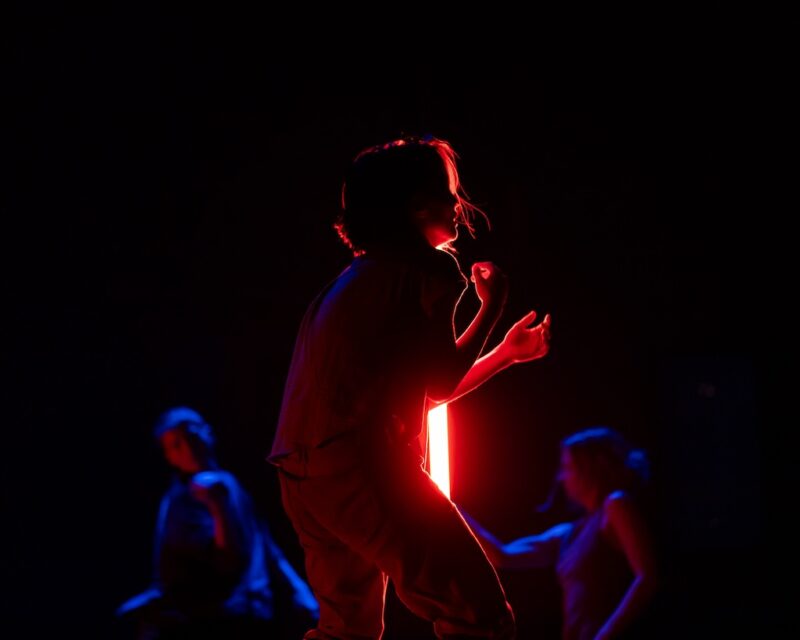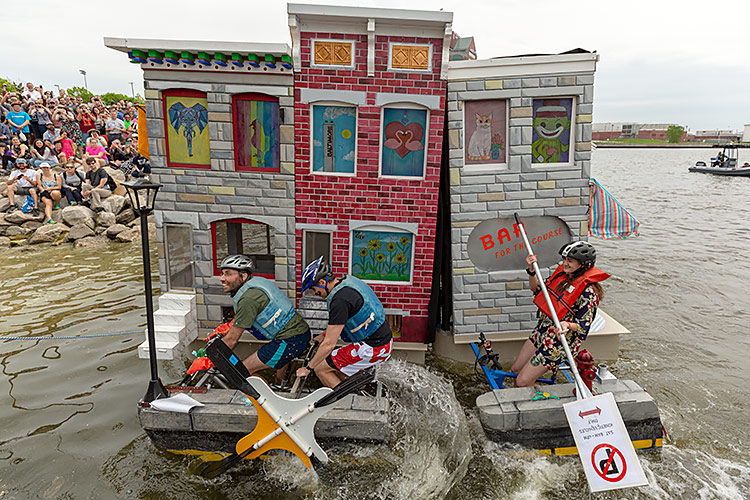On The Move: The mixed-media artwork in Intervenida, a solo show by Emily C-D at Loyola University Maryland, reflects the transformative power of travel and adventure. by Cara Ober
When you enter Intervenida, at the Julio Gallery at Loyola University Maryland, there will be a stupid grin on your face. I guarantee it. Like Baltimore’s best fall weather, the collage-based installations of Emily C-D are exuberant but in the most comfortable, pleasant way. Although the works on display here are, for the most part, large and ambitious, they’re not confrontational or exclusive, the way a lot of contemporary art presents itself. Instead, what you find is a quirky collection of old and abandoned objects, repurposed into a vibrant array of color and pattern, where individual objects are appreciated for their own intrinsic value but manage to coalesce elegantly into a cohesive structure.
The largest and most arresting piece, “Resplendor: La Mudanza” (The Move), features tumbling chairs, arcs of color, intricate stripes, and rusty cogs from antiquated machines. There’s even a nutcracker positioned deftly between wood scraps and a discarded ironing board. It sounds like a mess, but it’s not. Although it is a riot of color, texture, and pattern, “La Mudanza” comes together as one liquid motion. A swoop of color on the wall is reinforced by the chorus of found objects—big and small, some that are flat and others that break into three dimensions and ratchet out at you, adding to the motion and the visual drama. It is not surprising that the artist is directly inspired by the outdoor marketplaces of Mexico, especially the colored and patterned tarps that hang over the vendors’ merchandise.
C-D, based both in Baltimore and Mexico City, has been making art from garbage since she graduated from Maryland Institute College of Art in 2005. The practice started out of practicality and proximity: Her first job was with AmeriCorps, transforming abandoned city lots into gardens and public spaces in many of Baltimore’s poorest neighborhoods. Much of the work was manual labor, clearing out piles of discarded furniture and other items, and she wasn’t making a lot of money.
“I still don’t believe in paying for art supplies,” says C-D. “It takes more time, but I’ve always been able to find what I need. For example,” she says, gesturing to the wall installation, “for this piece I wanted some old chairs, so I took a walk on the west side and I found exactly what I needed.” Even the more traditional paper collages on display alongside the larger installations rely on the color, texture, and pattern from salvaged posters and signs from Mexico and a previous trip to India.
Although the artist trained at MICA to be an illustrator and has worked professionally for Baltimore’s City Paper and Urbanite, her main focus as an artist has become her relationship with the public and the public space. “I love meeting people, and I love using art as a way to do this,” says C-D, who has recently completed a number of public projects, both in Baltimore and in Mexico.
Under the name “Can Collective,” C-D and artist friends Jessie Unterhalter and Katey Truhn received a $20,000 PNC Transformative Arts Grant in July 2012 to create a double mural in Baltimore’s Franklin Square neighborhood and to give art workshops to young adults and children in the neighborhood. “We were in completely over our heads, but it was a great learning experience,” admits C-D without a trace of regret. C-D returned to Baltimore from Mexico this summer because of the grant. The two women worked long hours in Baltimore’s steamy summer weather to complete their project.
It was while working on the mural project that C-D came across a 6-foot metal screen that originally covered a round rosetta window in a nearby church. “It was just sitting there, and I just felt like I could do something amazing with it,” says C-D. “So I asked the church if I could have it.” The screen became the impetus for the other large installation that fills the gallery, the other centerpiece of the show at Loyola.
Part shrine, throne, and colorful vortex, the corner piece combines visual elements of Mexican folk art, Op Art, and Pop Assemblage. It fills the back corner of the gallery and comes off as both festive and meditative. At least 12 feet across and 6 feet high, the sculpture relies heavily on a giant piece of white paper, cut and folded as a framing element, which sets it apart physically from the ground and walls of the gallery. An intense blue-green sphere, painted directly on the wall and on a wooden shape on the floor, draws attention to its center; it allows complex patterns from the metal screen and the resulting shadows to vibrate with the movement of the viewer’s eye. In its center, a small yellow festoon diffuses the serious tension of the outer shapes and signifies a small celebration. The piece is visually dramatic but also seems to have a sense of humor about itself. This is true for most of the works included in the show.
The title of the exhibit, Intervenida, is Spanish, but it is close enough to its English equivalent, “intervention,” to be recognized. The English version alludes to an act of aggression or a possible rescue or resolution. However, according to C-D, in Spanish the term is much more nuanced and playful. As C-D’s art production has come to rely heavily on public art, public spaces, and interacting with all types of people, the word has come to embody her own evolving practice of openness and creativity. Rather than setting out to create a specific vision, the artist is informed by all the bits and pieces she collects from her environment. In this way, even the works she creates for a fine art gallery resonate with the energy of a specific place—and with the artist’s enthusiasm for each new encounter.
To see more images, go to: http://test.bmoreart.com/2012/09/photos-from-emily-c-d-at-loyola.html



